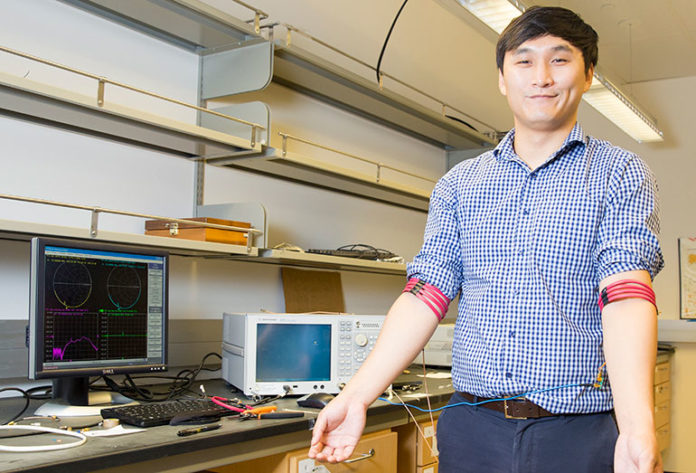
 Researchers at the UC San Diego Jacobs School of Engineering presented a new wireless communication method at the 37th Annual International Conference of the IEEE Engineering in Medicine and Biology Society in Milan, Italy. As wearables to track fitness become more and more popular, technology in biomedical sensors and devices also advances just as quickly. An important aspect of this technology is how these devices “talk” to one another. In the past, signals have been transmitted wirelessly with Bluetooth, which uses electromagnetic radiation. This type of signal propagation is severely impeded by human tissue and often requires a power boost to get the signal through. In their new study, the group was able to demonstrate a method called magnetic field human body communication, which uses human tissue as a communication medium instead of transferring the signals through air. The group developed a prototype consisting of copper wires and PVC tubes. One end is connected to an analyzer while the other end is coiled around three body parts (arm, head, and leg) to induce a magnetic field. This device successfully transferred signals from arm to arm and leg to arm. In fact, the group was able to demonstrate that the data loss was roughly 10 million times lower than what is associated with Bluetooth radios.
Researchers at the UC San Diego Jacobs School of Engineering presented a new wireless communication method at the 37th Annual International Conference of the IEEE Engineering in Medicine and Biology Society in Milan, Italy. As wearables to track fitness become more and more popular, technology in biomedical sensors and devices also advances just as quickly. An important aspect of this technology is how these devices “talk” to one another. In the past, signals have been transmitted wirelessly with Bluetooth, which uses electromagnetic radiation. This type of signal propagation is severely impeded by human tissue and often requires a power boost to get the signal through. In their new study, the group was able to demonstrate a method called magnetic field human body communication, which uses human tissue as a communication medium instead of transferring the signals through air. The group developed a prototype consisting of copper wires and PVC tubes. One end is connected to an analyzer while the other end is coiled around three body parts (arm, head, and leg) to induce a magnetic field. This device successfully transferred signals from arm to arm and leg to arm. In fact, the group was able to demonstrate that the data loss was roughly 10 million times lower than what is associated with Bluetooth radios.
The researchers also noted that this technique might offer improved security, as the signal rapidly weakens once its outside the human body. Some limitations to this study include the fact that the researchers did not evaluate the power consumption with this technique. Also, circular geometries are required for this method to work, though many wearable devices already come in loops such as a watch or a belt.
UC San Diego: Magnetic field provides a way to communicate wirelessly…
The post Magnetic Wireless Communication Opens Doors for Biosensors appeared first on Medgadget.
